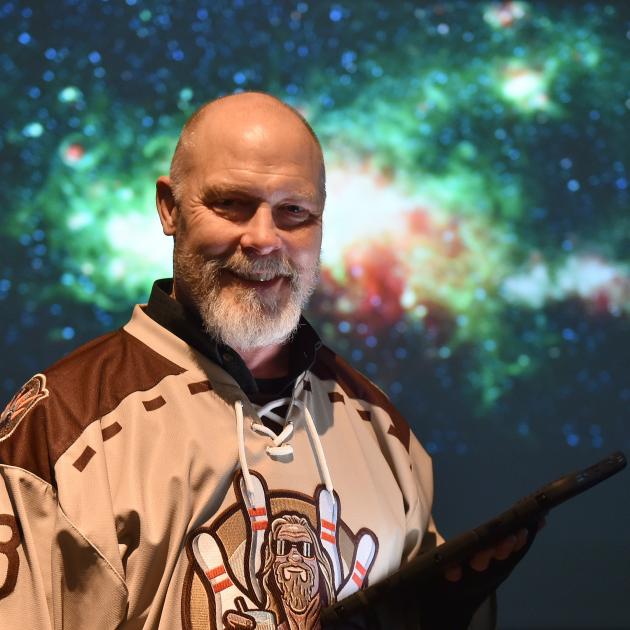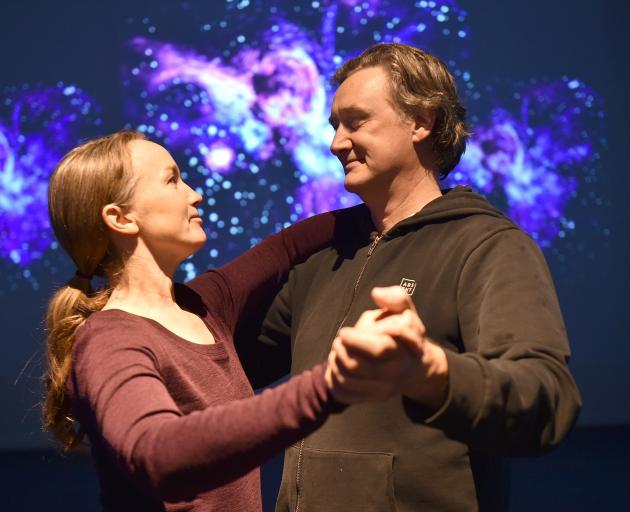
Matt Morgan’s work can often go unnoticed, yet without it a theatre production would not have the same impact. The Dunedin sound designer talks to Rebecca Fox about making visions a reality.
Anything she can think of I can probably create, says Matt Morgan.
It is a statement Morgan might think twice about making in the future as his director wife Kim does not need any encouragement to come up with ambitious theatre projects.
Like her latest - Constellations, a multi-media theatre production she conceived as Matt was climbing into a Santa Claus costume.
While waiting for him, Kim was shown around the Beautiful Science Gallery at Tūhura Otago Museum, which it is suggested is perfect for theatre.
‘‘And I had this blue streak of recognition, to take a phrase from one of our favourite plays. We’re going to do Constellations. And we’re going to do it in this space. And we’re going to use these amazing projectors to create a multimedia world around the audience. And it was all go from that moment,’’ Kim says.
As an astrophysicist in a past life herself, Kim has always loved Constellations by British playwright Nick Payne (2012) and has been dying to do it.
‘‘I just never had the right people, the right place. I never want to do a show if I’m just re-doing what someone else has done.’’
So after his Santa performance (an annual event), Matt was not at all surprised when Kim came to him with the idea.
‘‘We’ve been working together since ’96. We’ve done a lot of shows. I have learned that with Kim, her eyes get big and she starts saying, ‘Hey, come here. Look at this, look at this. What do you think?...’,’’ Matt says.
As Constellations follows Roland, a beekeeper, and Marianne, a quantum physicist, through their romantic relationship against a cosmic backdrop of ever-shifting realities across multiple universes that pull people’s lives in various directions, Kim felt it called for the set to be visualised in a ‘‘fluid visual way’’ as opposed to the static lighting surfaces of balloons and streamers the play was known for.
The twist with this one is that while Matt has been doing sound and technical work in theatre for nearly 50 years, including in Dunedin for the Fortune, Summer Shakespeare and WOW! Productions, he has not done multimedia visuals before and especially not on 14 high-tech projectors and a 6m by 3.5m screen.
Kim’s thinking was that Matt, a self-taught graphic designer who can create striking images ‘‘doodling away on his iPad at night’’, could create the visual content to augment the actors’ performance in the show.
Matt was up for the challenge, confident it was going to be a good show.
‘‘The fact she saw a show that has been sitting in her head forever, here realised in that moment, great. So how do we technically make that happen?’’
For Matt it has meant 18 months of upskilling himself, pulling in lighting expert Garry Keirle and seeking help from the museum’s own tech expert.
‘‘Luckily 40-plus years of doing technical theatre has given me a few tools. It’s the culmination of everything I have learned. So I get to use all those tools.’’

‘‘We have bees and flowers everywhere. And a bee did that wonderful thing where it went from one ear to the other right by my head. And I thought that’s the shift. That’s the Doppler effect - it gives you that ‘oh something’s just moved’, but it’s all the same.’’
He hopes all the effects will not pull the audience out of the action as they play out on the main screen behind the actors and on the walls on each side of the audience.
‘‘The walls around you shift somehow and there’s little sounds and the audience knows subliminally, if not objectively, something’s different. And they pick up the story on a completely different track, but it still looks the same.’’
Admittedly, it is a story that could be done in a black room or ‘‘you could throw all the bells and whistles at it’’, he says.
‘‘Our job is to find a happy medium where the actors shine and the story stays in the forefront. But all the multimedia and tech we throw at it helps make even richer the story of slightly different realities living side by side and makes sure the audience follows the story in a meaningful way. All we are doing is augmenting.’’
Kim believes he has found the ‘‘happy medium’’ to prime the audience for the next version of the story without going overboard.
‘‘And we’re doing all this on a system not made to do it.’’
Normally, Matt would run any sort of visuals off a computer program he has put all of his information into.
‘‘I just send it out as a video file but that is not how the system works. So I have to create separate video files and figure out how to trigger them and trigger them in sequence and time.
‘‘Whereas we’d normally have two days for tech, I think we have a week.’’
While originally the idea was for the audience to surround the actors, the set-up of the room did not allow for that and also there was one unexpected factor to consider - the noise from projectors’ fans. By moving the production into the back part of the room they could turn some of the projectors off during the actual production.
‘‘It kind of sounds like bees. And I often joke, being the astro geek I am, that it is cosmic background radiation noise, because if you listen to the cosmos, there’s always a hum to it. There’s scatter in the background. So we have this noise in this room like the cosmos. But it is a challenge we have to be aware of ,’’ Kim says.
Despite the technical challenges, Matt is loving the experience. After a few years off with health-related issues, it is his first big project back with Kim. It is also the couple’s inaugural production for their new production company Hic Sunt Dracones (‘‘Here be Dragons’’).
The pair met while working on a production of Angels in America 28 years ago and then got together 20 years ago after Kim moved to Denver after graduate school and started working at the same university.
Kim even took his class so she could learn technical ‘‘speak’’.
Matt tells Kim when she is driving him to the point of madness with her director’s grandiose ideas of pools of water on stage and pyrotechnics.
‘‘The technical director gets to be the person who pulls their hair out and says, ‘OK, that’s possible. But here’s what it’s gonna take, do you really need it?’ So we’ve had a lot of fun going round and round over the years in the best collaborative way, figuring out how to take this big vision and make it practical, and to serve the story that you’re telling, because sometimes you get these lovely tech ideas. Oh, wouldn’t that be fun? And the technical director is the one who brings you back to earth,’’ Kim says.
While she moved from science to theatre, Matt, the youngest of five and the son of a university professor, has always been a sound designer, crediting his start in the industry as being marched off to summer theatre with a neighbour at 10 years old.
His fascination with sound began when his brother came home from the army in the early 1970s with ‘‘the best stereo system I’d ever seen in my life’’, including a reel-to-reel.
By the time he got to university he had plenty of experience acting and as he played music, the idea of the emerging sound and effects in theatre appealed. It was the early 1980s and he was watching the movies with amazing soundtracks.
‘‘I was thinking how do you apply that to theatre. How do you take those tonal qualities in movies that you don’t notice? If you’re watching the movie, there’s always something there suggesting a feeling.’’
Like in the movie Jaws when the John Williams soundtrack suddenly stops and the head pops up and it’s the dead body not the shark.
‘‘But God, everybody jumped out of their seats. I thought ‘I want that, I want to do that’.’’
Matt became one of the first to figure it out for theatre.
‘‘So he didn’t get a degree in it, because he was out there doing it and teaching other people how to do it,’’ Kim says.
Later at the University of Denver he coined a term for this sort of effect, ‘‘psycho-acoustic manipulation’’. While many people might not think they are sound designers, there are very few who have not made a ‘‘mixed tape’’ or playlist over the years.
‘‘And it’s exactly that - it’s taking noises and making you feel something. You’re a sound designer; you made a succession of sounds to cater to a mood. Feeling and then putting something to that feeling. This is ‘‘my girlfriend’’ soundtrack. This is my ‘‘I hate my boyfriend’’ soundtrack. This is my ‘‘drive too fast’’ track, right? And all those things come from the same place in the designers’ world.’’
Some designers create their own noises to make that feeling, others blend existing sound together to do the same. Matt has been writing music for theatre and Kim’s shows for years.
Back in the day Matt learnt how to cut tape and splice it back together on reel-to-reel tape but now he does the same thing on computer - it just takes 10 minutes instead of hours.
‘‘I still know how to use tape and I still love the analog sound. But the digital ease, especially doing theatre, where you’ve got to be able to do things quickly and on a budget...’’
Adding the video work to those skills has been a bonus.
‘‘The video and the interpretation of that is the new and exciting part, I think.’’
TO SEE:
Nick Payne’s CONSTELLATIONS
Beautiful Science Gallery
at Tūhura Otago Museum
May 23 to 26 and May 29 to June 1












